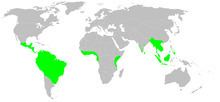Kingdom Animalia Subclass Lissamphibia | Phylum Chordata Rank Order | |
 | ||
Clade Gymnophiona
Rafinesque, 1814 Lower classifications Atretochoana, Typhlonectes natans, Cayenne caecilian, Aquatic caecilians | ||
Gymnophiona ormepadde
Gymnophiona is the group of amphibians that includes the legless caecilians and all amphibians more closely related to them than to frogs or salamanders (the "stem-caecilians"). The name derives from the Greek words γυμνος (gymnos, naked) and οφις (ophis, snake), as the caecilians were originally thought to be related to snakes.
Contents
- Gymnophiona ormepadde
- Reptiles amphibians invertebrates small pets caecilian facts
- Evolution
- Relationships
- References
Reptiles amphibians invertebrates small pets caecilian facts
Evolution
Little is known of the evolutionary history of the caecilian lineage, which has left a sparse fossil record. The first fossil belonging to this group, a vertebra dated to the Paleocene, was not discovered until 1972. The putative earliest fossil known comes from the Jurassic period; its primitive genus, Eocaecilia, had small limbs and well-developed eyes.
In their 2008 description of the fossil batrachian Gerobatrachus, Anderson and co-authors suggested that caecilians arose from the Lepospondyl group of ancestral tetrapods, and may be more closely related to amniotes than to frogs and salamanders, which arose from Temnospondyl ancestors. Numerous groups of lepospondyls evolved reduced limbs, elongated bodies, and burrowing behaviors, and morphological studies on Permian and Carboniferous lepospondyls have placed the early caecilian (Eocaecilia) among these groups. Divergent origins of caecilians and other extant amphibians may help explain the slight discrepancy between fossil dates for the origins of modern amphibia, which suggest Permian origins, and the earlier dates, in the Carboniferous, predicted by some molecular clock studies of DNA sequences. Most morphological and molecular studies of extant amphibians, however, support monophyly for caecilians, frogs, and salamanders, and the most recent molecular study based on multi-locus data suggest a Late Carboniferous–Early Permian origin of extant amphibians.
Relationships
The most recent phylogeny of caecilians is based on molecular mitogenomic evidence examined by San Mauro et al. (2014).
